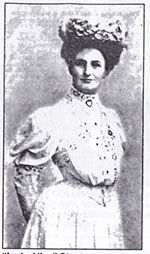As the newspaper of the Archdiocese of Los Angeles, the Tidings has had 21 head editors over 120 years. Only one, Alice J. Stevens (1860-1947), has been a woman.
Stevens was editor of the Tidings from July 17, 1908 to October 15, 1913. Born in 1860 in Sutter County, California (near Sacramento), to a Methodist family, she began her newspaper career as a real estate editor for the Los Angeles Times. Sometime in her 40s, Stevens converted to Catholicism, and brought her talents to The Tidings; first, as a contributor to the “Women’s Page,” and then, encouraged by Bishop Thomas J. Conaty, by launching a “Young People’s Column” in 1906. It later became one of the paper’s most popular features.
Stevens took instructions and was received into the Church by Father John J. Clifford — who served as editor of The Tidings for roughly a year following Herman J. Rodman’s death. He eventually submitted her name for consideration as his successor as editor.
This suggestion was initially met with opposition, due to then-president and chairman of the board of directors, C.C. Desmond’s qualms about having a female editor. Father Clifford eventually convinced Desmond that “Aunt Alice” was up to the task.
She certainly proved she was. Msgr. Francis J. Weber writes in his history of the newspaper that she “insisted that The Tidings be operated as a sound business venture.”
Among the steps she took in that vein was moving the paper into the Higgins Building at Second and Main streets, just half a block away from St. Vibiana’s, then the official cathedral of the see of Los Angeles. The “accomplished administrator” saw this closeness between the newspaper’s and diocesan office as sensical, efficient and proper.
As far as content, the years 1908-1913 were marked by Stevens’ literary background and “human approach” to stories, including interviews with and features on Mother Frances Xavier Cabrini, Cardinal John Farley and Father Bernard Vaughan, written by Stevens herself. One 1909 issue featured a travelogue on San Juan Teotihuacan, Mexico, and its pyramids.
Other regular features during this time included “Doctrine and Devotion: Compiled Especially for The Tidings,” which included a weekly calendar with feast days, a sermonette and “Saints of the Month”; “Spiritual Pepper and Salt,” by Bishop Stang, featuring questions such as, “Is one church as good as another?”; “From Our Regular Irish Correspondent,” a “Newsy weekly letter from OBM who keeps us in touch with affairs in the old country”; and “Under the Library Lamp: Personal Chats About Catholic Events, Specially Contributed to the Tidings,” by Mrs. S.M. O’Malley.
During her tenure as editor, Stevens, “an unassuming person,” according to Msgr. Weber, did not allow herself to be listed on the masthead. (The masthead did include, however, the address of The Tidings Publishing Company, the terms of subscription, and the names of the president (C.C. Desmond), vice-president (W.E. Hampton), treasurer (James C. Kays) and manager (James Nolan)).
The only clue that Stevens was a Tidings employee was that the letters in “The People’s Corner” were all addressed, “Dear Miss Stevens.” Stevens opened that section’s “Correspondence Corner” by referring to the readers as “my dear children.”
Stevens also instated a bastion of the The Tidings, the “El Rodeo” column. It first ran on October 6, 1911. The column then served the purpose of presenting items which were too short or otherwise inappropriate for a full story. The first “El Rodeo” column included the following quote from Ave Maria magazine:
“One mistake to be guarded against in the discussion of Feminism, the emancipation of women, Woman Suffrage, and the like topics, by Catholic preachers and writers, is that of identifying their personal opinion with infallible dogmas of the teaching Church. As a matter of historical fact, Catholic women in more than one quarter of the globe do exercise the right (or privilege) of the suffrage; and we have not noticed that by doing so they are incurring excommunication, major or minor.”
Stevens resigned as editor in the fall of 1913 to marry William Tipton, a legal expert on Spanish land grants. She is quoted as saying becoming a wife is to “accept a woman’s high place in life.” She moved to Pacoima after Tipton’s passing, and lived there until her death in 1947.
Stevens edited the paper at an incredible time in history: Shortly after her taking helm of The Tidings (October 1908), the first Model T Ford was produced. In 1910, Los Angeles hosted the U.S.’ first air meet, at Dominguez Field, and in 1912, two new states (New Mexico and Arizona) were admitted to the Union.
She also edited the paper at a time when she was not allowed to vote in California until halfway through her tenure, October 11, 1911. (The 19th amendment, federally prohibiting the denial of the right to vote on the basis of sex, was not ratified until Aug. 18, 1920). Surely C.C. Desmond was not the only person who had doubts about her abilities. Yet, by all accounts, she excelled at what she did.
She was the first woman to address the Knights of Columbus and the Newman Club. She was the only woman present at the 1922 charter meeting of the Catholic Press Association, where she was unanimously chosen as a member and secretary of the directorate.
Charles C. Conroy, her successor, is quoted as saying, Alice “had done most excellent work and had been recognized as one of the leading Catholic editors in the United States.”
I should have liked to have known Miss Stevens. I would love to see her reactions to our newsroom of today. From one female editor to another, cheers to you, Miss Stevens!

